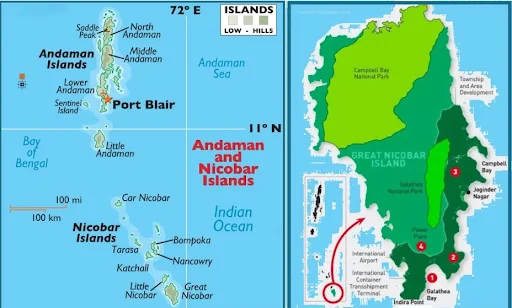Introduction
- The Great Nicobar Island Development Project, valued at ₹72,000 crore, is one of India’s most ambitious infrastructure plans, aiming to transform this strategically located island into a key hub for defence, commerce, logistics, and eco-tourism.
- With the introduction of new additions such as an international cruise terminal, high-end tourism facilities, and a shipbreaking yard, the project has stirred significant interest and concern.
- While the infrastructure developments promise substantial economic growth, they also pose serious challenges related to the environment, indigenous communities, and long-term sustainability.
Great Nicobar Island (GNI)
|
Read also: Yarlung Tsangpo Dam: Key Details for UPSC Aspirants
What is the Great Nicobar Island Development Project?
- The Great Nicobar Island Development Project, led by the Andaman and Nicobar Islands Integrated Development Corporation (ANIIDCO), is a ₹72,000 crore initiative aimed at upgrading the island’s infrastructure.
- The project spans 16,610 hectares and focuses on leveraging the island’s strategic location near the Malacca Strait—a key maritime passage that connects the Indian Ocean to the Pacific.
- Key components of the development include:
- International Container Transshipment Terminal (ICTT)
- Greenfield International Airport
- Two New Greenfield Cities
- Coastal Mass Rapid Transport System
- Free Trade Zone
- International Cruise Terminal (New addition)
- Shipbreaking Yard (New addition)
Why is the Great Nicobar Island Development Project Significant?
- Economic Growth: The establishment of an ICTT and an international airport on Great Nicobar Island will place the region on the global trade map.
- For instance, the ICTT’s expected throughput of 2.2 million TEUs (Twenty-foot Equivalent Units) annually could significantly boost the maritime trade volume in India.
- This will also contribute to the Make in India initiative by facilitating trade for Indian manufacturers.
- Additionally, the project will provide a much-needed boost to the local economy, creating an estimated 50,000 direct and indirect job opportunities.
- Tourism and Social Development: The project holds great potential for boosting tourism in the region, thanks to the development of a world-class international cruise terminal and eco-tourism facilities. The tourism sector alone is projected to generate over ₹500 crore in revenue annually, benefiting local businesses and communities. The island’s natural beauty and rare biodiversity can attract global tourists, contributing to the local economy. Additionally, the project promises improvements in healthcare, education, and connectivity, further fostering the social upliftment of the region.
- Geo-Strategic Importance: Great Nicobar Island is strategically positioned near the Malacca Strait, through which over 25% of global trade passes annually. It is one of the world’s busiest maritime routes. The strategic location also allows India to increase its maritime influence in the Indo-Pacific region, which is becoming increasingly important due to global trade dynamics and security concerns. In this context, the project aligns with India’s “Act East” policy, designed to enhance economic and strategic ties with Southeast Asia and the broader Indo-Pacific region.
- Strengthening National Security: The strategic location of Great Nicobar Island will significantly enhance India’s defense preparedness in the Bay of Bengal, a region that has become a focal point for China’s growing naval presence. China’s increasing activities in the Indian Ocean and its investments in maritime infrastructure, such as ports in Sri Lanka and Pakistan, have raised concerns about India’s maritime security. By developing military infrastructure on Great Nicobar Island, including advanced airfields, surveillance systems, and naval bases, India can strengthen its ability to monitor and control this critical maritime corridor.
- The proximity of Great Nicobar Island to the crucial shipping lanes in the Bay of Bengal and its location at the southern tip of the Andaman and Nicobar Islands will provide India with a strategic advantage in monitoring Chinese naval movements in the region.
- This enhanced surveillance capability will allow India to maintain a robust deterrence against any security threats while reinforcing its maritime dominance.
- Environmental Sustainability and Global Responsibility: The project lies in one of the most ecologically sensitive regions of India, home to endangered species such as the Nicobar megapode and the leatherback turtles. The Galathea Bay Wildlife Sanctuary, which is part of a UNESCO World Heritage site, underscores the need for environmentally responsible development.

Associated Concerns with the Project
- Seismic and Disaster Risks: The Great Nicobar Island lies in a seismically sensitive region, as demonstrated by the 2004 tsunami, which caused permanent subsidence of approximately 15 feet. Building large-scale infrastructure, particularly a port, in such a disaster-prone area raises questions about the project’s long-term safety and viability.
- Lack of Consultation and Transparency: Critics argue that the project has proceeded without sufficient consultation with key stakeholders, including local communities and the Tribal Council. The development is progressing without a full consultation with these groups, particularly the Shompen and Nicobarese tribes, who have lived on the island for centuries and whose rights are enshrined in India’s Forest Rights Act (2006). Additionally, the National Green Tribunal’s review of the environmental clearances has not been made public, fueling concerns over transparency in the decision-making process.
- Environmental Impact: The development threatens to destroy the island’s unique ecosystem, which is home to endangered species like the leatherback turtles. The felling of nearly a million trees could severely disrupt the island’s biodiversity. For instance, the Nicobar megapode, a ground-dwelling bird found only on the Nicobar Islands, could face severe habitat destruction due to the loss of forest cover. Although compensatory afforestation is planned in Haryana, it does not compensate for the loss of biodiversity in the immediate area.
- Threat to Indigenous Tribes: The Shompen and Nicobarese tribes, the island’s indigenous communities, face displacement and loss of their ancestral land. The project risks violating the Forest Rights Act (2006), which grants indigenous communities the authority to protect and manage their tribal reserves. It’s essential that their rights and traditions are respected throughout the development process.
- International Obligations: Great Nicobar Island is home to the Galathea Bay Wildlife Sanctuary, a UNESCO World Heritage Site. The preservation of this sanctuary is not only crucial for India’s biodiversity but also an international obligation. For instance, the destruction of critical habitats for endangered species could undermine India’s efforts to fulfill its obligations under the Convention on International Trade in Endangered Species (CITES).
- Economic Viability: The economic feasibility of the project remains a topic of debate. Great Nicobar Island is situated far from other major transshipment hubs in Southeast Asia. The nearest major Indian ports, such as Chennai and Kolkata, are approximately 1,300 km away, which raises questions about the economic efficiency of creating another transshipment terminal in such a remote location. The absence of a hinterland or industrial infrastructure to support the proposed free trade zone makes the project seem economically unviable. Additionally, the inauguration of a new transshipment terminal in Vizhinjam, Kerala, raises questions about the necessity of replicating such infrastructure in Great Nicobar.
Way Forward
- Reassessment of Economic Feasibility: A comprehensive economic reassessment should be conducted to determine whether the project is financially viable, given the proximity of established transshipment hubs in Singapore, Malaysia, and Sri Lanka. This should include a cost-benefit analysis that considers both the direct and indirect economic impacts.
- Comprehensive Social and Environmental Impact Assessment: A thorough Social and Environmental Impact Assessment (SEIA) must be conducted to evaluate the long-term effects of the project. This assessment should address concerns raised by local stakeholders, including the Campbell Bay Panchayat, regarding potential social disruptions and environmental degradation.
- Respect for Tribal Rights: The project must be carried out with the utmost respect for the rights of the indigenous communities, especially the Shompen and Nicobarese tribes. The Shompen Policy of 2015, which prioritizes the protection of tribal rights over large-scale development projects, should be followed rigorously.
- Separate Security and Development Goals: The military infrastructure development should be considered independently from the civilian infrastructure initiatives. This will ensure that the island’s security needs are met without compromising its environmental integrity or the rights of indigenous people.
- Eco-Friendly Construction Practices: The construction of infrastructure should adhere to eco-friendly practices, such as using sustainable building materials and adhering to green building standards like the GRIHA code. This will help minimize the environmental footprint of the project.
- Transparency in Data and Decision-Making: Transparency in the planning and execution phases is essential. The government should release all data related to the project, including the rationale behind decisions, stakeholder consultations, and environmental assessments. This will ensure that the development process is open to scrutiny and can foster informed public debate.
- Exploration of Other Islands: Instead of focusing solely on Great Nicobar Island, the government should consider spreading the development across other islands in the Nicobar group, such as Little Nicobar, Nancowry, Kamorta, and Katchall. This would reduce the environmental and social impact on Great Nicobar Island, allowing for the development of infrastructure in a more balanced manner.
- Enhanced International Cooperation: Collaborating with countries like Japan, South Korea, and other island nations can help India develop sustainable models of island infrastructure that balance economic growth with environmental protection.

